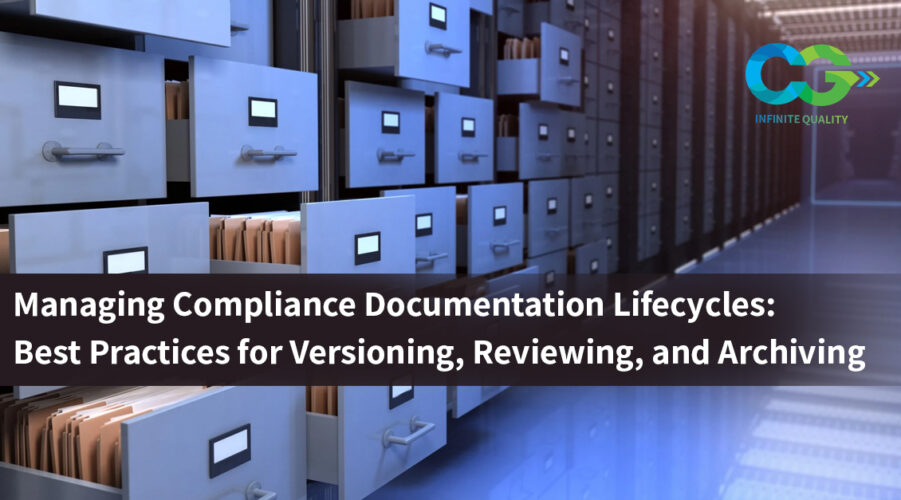
Article Context:
A robust approach to managing compliance documentation lifecycles is fundamental for any organization navigating a complex regulatory landscape. By establishing clear processes for document creation, approval, retention, and disposal, organizations can demonstrably achieve and maintain compliance with relevant regulations. This not only mitigates the risk of hefty fines and penalties but also fosters a culture of accountability within the organization. Furthermore, streamlining documentation lifecycles through automation and centralized storage solutions optimizes operational efficiency by minimizing wasted time and resources spent searching for or recreating outdated documents.
Here are some best practices for versioning, reviewing, and archiving compliance documentation:
Best Practice for Document Versioning:
Standardize Document Naming Convention: Establishing a standardized document naming convention is the cornerstone of robust version control within the organization.
Standardizing document naming conventions are crucial for maintaining clarity and consistency within the documentation processes. This will apply to new and old versions of all documents within the organization.
Standardizing file naming conventions promotes clarity, transparency, and improved document organization. Implementing a consistent system across all departments minimizes confusion and streamlines document retrieval for everyone.
An ideal file name for a document should include:
- Document Title
- Consistent Version number
- The date of the latest revision.
For instance, a document could be named “ABC ProjectPlan_v2_06282024,” indicating the second version of the ABC Project Plan, updated on June 28, 2024
Pro Tip: Strengthen your document naming convention by incorporating clear and concise tags. These tags can reflect the document's content (e.g., "marketing plan," "financial report") or stage in the workflow (e.g., "draft," "in review," "final"). This user-friendly approach allows for quick identification of document status, content, and purpose, ultimately streamlining document sorting and retrieval.
For example, “FinancialReport_Final_v3_06282024” immediately clarifies the document’s nature and stage in the document.
For effective document management, it's highly recommended to include a version control table within each document. This table should track key information like author and a concise summary of changes made in each iteration. By incorporating this table, users can effortlessly retrieve the specific document version they need and understand the evolution of the content.
Version Control:
Documentation tools with version control help you manage changes to the documents over time. This means every edit, update, and revision is tracked and saved as a separate version. This organized system ensures:
Accuracy: You can be confident you're always working with the latest information.
Clear History: A complete audit trail shows who made changes and when, making it easy to track progress.
Seamless Collaboration: Multiple team members can work on the same document simultaneously without accidentally overwriting each other's work
Implement a standardized version control system to track changes and revisions to compliance documents. Clearly label each version with a unique identifier (e.g., version number or date) to differentiate between iterations.
Ensuring Document Integrity Through Access Controls:
Maintaining the integrity of compliance documents is paramount task. Uncontrolled editing can lead to a cascade of issues, including data inconsistencies, compliance breaches, and potential loss of vital information
Mitigate the risks of unauthorized edits and maintain document integrity with granular access controls within the version control system. Restrict editing permissions to authorized individuals based on their roles. For instance, in a project plan, only project managers and team leads would have edit access, while others might have read-only permissions. This ensures deliberate edits by the right people, safeguarding the document's accuracy and validity
Best Practice for Document Reviewing:
A well-defined review process is the cornerstone of ensuring your compliance documents are accurate, complete, and meet all regulatory requirements. Here's how to create a robust review framework:
Establish a multi-stage review process that caters to different aspects of the document. This could include stages such as:
Document the Review Process: Formalize the review process in a documented procedure, outlining the roles, responsibilities, timelines, and communication channels. This ensures transparency and fosters a consistent approach to reviewing all compliance documents.
Assign Roles and Responsibilities: For each review stage, designate specific individuals or teams responsible for conducting the assessment. Consider factors like expertise, workload, and potential conflicts of interest when assigning roles.
Develop Review Checklists: Create standardized checklists for each review stage, outlining the specific aspects reviewers should evaluate. This ensures consistency and reduces the risk of overlooking crucial elements.
Establish Timelines: Set clear deadlines for each review stage, fostering a sense of urgency, and ensuring timely completion of the review process. Consider potential bottlenecks and allocate sufficient time for thorough evaluations.
Cross-Functional Review Teams:Involve cross-functional teams in the review process to ensure comprehensive evaluation from different perspectives. Include representatives from relevant departments, such as legal, compliance, operations, and quality assurance.
Feedback Mechanisms: Provide mechanisms for stakeholders to provide feedback and comments during the review process. Encourage open communication and collaboration to address any issues or concerns raised by reviewers.
Best Practices for Document Archiving:
In regulated industries like healthcare and pharmaceuticals, meticulous archive organization is an indispensable cornerstone of legal compliance. Maintaining historical records in a well-structured and readily accessible manner demonstrably mitigates the risk of non-compliance penalties and associated legal complications. Below is the list of best practices for compliance document Archiving.
Develop a document retention policy: A well-defined document retention policy stands as a cornerstone of effective information governance within any organization. It dictates the lifecycle of various document types, ensuring they are retained for the necessary timeframe while eliminating the burden of storing extraneous data. Develop and enforce retention policies specifying the duration and requirements for retaining compliance documents based on regulatory obligations and internal needs. Ensure compliance with relevant legal and industry standards governing document retention.
Secure Storage: Store archived compliance documents in secure and accessible repositories, such as electronic document management systems (DMS) or cloud-based storage platforms. Implement encryption, access controls, and backup mechanisms to safeguard sensitive information.
Indexing and Searchability: Index archived documents and establish metadata standards to facilitate easy search and retrieval of information. Organize documents into logical categories and folders, applying descriptive tags and keywords for efficient searching.
Regular Audits and Reviews: Conduct periodic audits and reviews of archived compliance documents to ensure completeness, accuracy, and compliance with retention policies. Identify any obsolete or redundant documents for disposition or archival consolidation.
Secure your archive with granular access control: To safeguard the integrity and confidentiality of the compliance documents, implement a robust access control system within the archive. This system should restrict access solely to authorized personnel, mitigating the risk of unauthorized intrusion.
Optimizing Compliance with Document Lifecycle Management
In today's highly regulated environment, robust Document Lifecycle Management (DLM) practices are fundamental for ensuring adherence to compliance mandates and streamlining document workflow key components:
Lifecycle Mapping: Map out the entire lifecycle of compliance documents, from creation and review to archiving and disposal. Define milestones, checkpoints, and decision points at each stage of the lifecycle.
Automated Workflows: Implement automated workflows and document management systems to streamline document lifecycle processes, including versioning, reviewing, approval, and archiving. Use workflow automation to enforce consistency, reduce errors, and accelerate document processing.
Continuous Improvement: Continuously evaluate and refine document lifecycle management processes based on feedback, lessons learned, and changing regulatory requirements. Foster a culture of continuous improvement to enhance efficiency and effectiveness over time
Conclusion:
By implementing these best practices for managing compliance documentation lifecycles, organizations can ensure the integrity, accessibility, and compliance of their documentation while optimizing operational workflows and minimizing risks.

AUTHOR:
Siva Kalidoss
Assoc Director, Delivery
